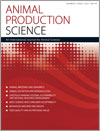
Animal Production Science
Volume 53 Number 5 2013
AN12209The oral administration of meat and bone meal-derived protein fractions improved the performance of young broiler chicks
Containing up to 50% protein, meat and bone meal (MBM) is a prospective source of bioactive peptides that may stimulate beneficial modification of physiological processes. In this study the 3-100 kDa MBM derived peptide fraction significantly increased broiler chick feed intake and weight gain. Identification of the bioactive protein(s) in MBM could facilitate the development of novel markets for MBM and, the creation of new applications in the chicken meat industry.
AN12363Steam-pelleting temperatures, grain variety, feed form and protease supplementation of mediumly ground, sorghum-based broiler diets: influences on growth performance, relative gizzard weights, nutrient utilisation, starch and nitrogen digestibility
The performance of broilers offered sorghum-based diets is inconsistent or even suboptimal. This study investigates steam-pelleting temperatures, sorghum variety, feed form and protease supplementation on broiler performance and all four factors were influential so there are instructive outcomes. Protease increased N digestibility, which is in itself promising, but also enhanced starch digestibility, which has interesting implications.
AN12291Optimal dietary zinc levels of broiler chicks fed a corn–soybean meal diet from 22 to 42 days of age
Zinc plays important roles in numerous cellular activities and physiological functions in animals. This study has demonstrated that the gene expression analysis provided a powerful means of assessing the optimal dietary Zn requirement for broilers, and some gene expression indices could be used as sensitive biomarkers for the estimation of the dietary Zn requirement of broilers.
AN12202Genetic parameters and phenotypic trends in the mean and variability of number of stillborn piglets and changes in their relationships with litter size and gestation length
Stillborn piglets (SB) recorded over 15 years in commercial pigs were examined. Over this period of time, SB had increased by 0.2 piglets and the total number of piglets born per litter (TB) increased by 0.5 piglets. Unfavourable phenotypic and genetic correlations between SB and TB were slightly stronger in a more recent dataset than in older data, further highlighting the need to develop genetic and management strategies to prevent a continued increase in SB.
AN12242Genetic polymorphism at the CSN1S1 gene in Girgentana dairy goat breed
In dairy goat populations, the CSN1S1 genotypes should be considered in order to incorporate this information in the selection processes. The aim of this work was to evaluate the variability of the αs1-casein locus in the endangered Girgentana dairy goat breed. The CSN1S1 genotype information could be used to define genetic improvement and conservation program for this breed, considering that preservation of breeds in danger of extinction could be achieved by establishing economic reasons for their survival.
AN12081A survey of free and conjugated deoxynivalenol in the 2009, 2010 and 2011 cereal crops in Australia
Vomitoxin (DON), a toxin produced by moulds, was detected in grain samples collected from the 2009, 2010 and 2011 crops in Australia, with the highest level obtained being 7.31 µg/g, which is almost four times greater than the critical regulatory limit for human consumption. Derivatives of vomitoxin, which are not normally detected, were also found in 61–87% of contaminated grain samples. The presence of these derivatives indicates the challenges in understanding the hazard posed to human and animal health by vomitoxin-contaminated grains.
AN12124Effects of increasing supplementation levels of rice bran on milk production and fatty acid composition of milk in Saanen dairy goats
In this study, the effect of supplementing dairy goat diets with rice bran on milk yield and composition was evaluated. Four levels of supplementation were tested: 0, 5, 10, and 20% of the total diet. The results indicate that rice bran supplementation, if kept below 10%, can increase the yield and fat content of milk.
AN12196Effect of inclusion of grasses and wet hulless-barley distillers’ grains on the fermentation and nutritive quality of oat straw- and straw-grass silages in Tibet
The lack of forage is an important limiting factor for sustainable development of livestock production in the Tibet plateau, which is called the Earth’s third pole. Ensiling oat straw with tall fescue showed that adding wet hulless-barley distillers’ grains to mixed silage can be a feasible strategy for solving the forage shortage when grass is insufficient in Tibet.
AN12025Effect of cereal and pea monocultures and combinations and silage additives on whole-crop cereal silage nutritive and fermentation characteristics
Winter forage cereals grown for grazing and silage can achieve high dry matter yields over the winter and spring period but often nutritive characteristics of resultant silages are low. This experiment evaluated silage nutritive and fermentation characteristics of winter wheat, triticale, forage peas and bi-crops of cereals and peas cut for silage at the soft dough growth stage of the cereals and ensiled with and without bacterial inoculant additives. Results indicated that forage peas can be ensiled with winter cereals to produce silages with higher CP concentrations than cereal silage and there is potential to use monocultures of forage peas to produce silages with higher estimated ME and CP concentrations than cereal or cereal–pea combinations.
AN12140Potential impacts of negative associative effects between concentrate supplements, pasture and conserved forage for milk production and dairy farm profit
Feeding supplements in a partial mixed ration system should offer advantages by reducing substitution and negative associative effects between feed because the rumen is more stable than when grain is fed in the dairy twice a day. This study investigated the potential economic benefits of feeding a partial mixed ration on two case study farms. While profit and return to the business increased, the results highlighted that further research is needed to quantify changes in efficiency of metabolisable energy use when mixed rations are fed in grazing situations.
AN11307Effect of Stylosanthes guianensis supplementation on intake and nitrogen metabolism of Bos indicus cattle offered a basal diet of mixed rice straw and tropical grass
Cattle nutrition in tropical areas depends on rice straw and tropical grass diet, which is insufficient in fermentable energy and protein. By supplementing ~30% legume (DM basic) to a mixed rice straw and grass diet, intake and microbial protein production were improved to achieve weight gaining of Bos indicus cattle. Using legume (Stylosanthes guianensis), as part of an eco-farming system, is a key solution for smallholder farmers to improve their cattle production.
AN12134Factors involved in high ewe losses in winter lambing flocks grazing dual-purpose wheat in southern New South Wales: a producer survey
Dual-purpose wheat can fill the winter feed-gap for winter lambing flocks in southern Australia, however high ewe losses have been reported with this practice. This survey identified metabolic diseases as a key cause of high ewe losses on grazing wheats in southern NSW, and found that feeding mineral supplements and managing ewe condition are two practices that may prevent high losses occurring. By managing the risks farmers can utilise winter wheats for grazing by reproducing ewes, improving flock health and productivity.
AN12279A higher proportion of female lambs when ewes were fed oats and cottonseed meal prior to and following conception
Sheep producers would benefit from being able to skew the sex ratio of lambs towards their preferred gender, for example, first-cross ewe enterprises prefer breeding females. The proportion of female lambs was significantly higher when ewes were fed a diet based on oats and cottonseed meal high in omega-6 fatty acids compared with a control diet based on silage low in omega-6. Feeding ewes a diet based on oats and cottonseed meal at joining may provide a practical means by which producers are able to alter the sex ratio of lambs in order to meet specific production targets.
AN12247Evaluation of semen characteristics of the species Mazama americana in captivity
Approximately one-third of the deer in the world are classified as rare or endangered, and the banks of cryopreserved genetic material (genomic banks), are important tools for conservation. Any future application of artificial breeding or natural breeding would require knowledge of species-specific reproductive parameters, some of which were the subject of this paper. There is little scientific attention on the characterisation of deer semen, and the results help to create a genomic bank for the conservation of neotropical deer.



